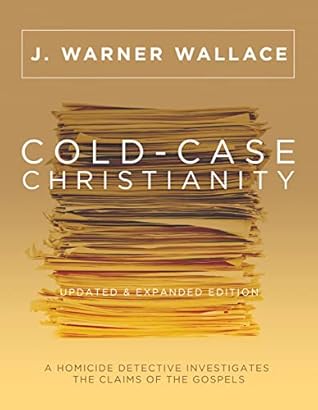More on this book
Community
Kindle Notes & Highlights
Read between
February 13 - March 3, 2025
Alan’s philosophy was hurting his methodology. We weren’t following the evidence to see where it led; we had already decided where the evidence would lead and were simply looking for affirmation. Luckily, the truth prevailed.
Objectivity is paramount; this is the first principle of detective work each of us must learn. It sounds simple, but our presuppositions are sometimes hidden in a way that makes them hard to uncover and recognize.
Philosophical naturalism rejects the existence of supernatural agents, powers, beings, or realities. It begins with the foundational premise that natural laws and forces alone can account for every phenomenon under examination.
Scientists aren’t alone; many historians are also committed to a naturalistic presupposition.
I began to understand the hazard of philosophical presuppositions while working as a homicide detective.
Begging the Question
all of us have a point of view; all of us hold opinions and ideas that color the way we see the world. Anyone who tells you he (or she) is completely objective and devoid of presuppositions has another more important problem: that person is either astonishingly naive or a liar.
The question is not whether we have ideas, opinions, or pre-existing points of view; the question is whether we will allow these perspectives to prevent us from examining the evidence objectively.
If God did exist, He was the creator of everything we see in the universe. He, therefore, created matter from nonmatter, life from nonlife; He created all time and space.
I failed to differentiate between science (the systematic, rational examination of phenomena) and scientism (the refusal to consider anything other than natural causes).
detectives aren’t the only people who use abductive reasoning to figure out what really happened. Historians, scientists, and all the rest of us (regardless of vocation or avocation) have experience as detectives.
All of us have learned the intuitive difference between possible and reasonable.
When it comes right down to it, just about anything is possible.
While it’s interesting to imagine the possibilities, it’s important to return eventually to what’s reasonable, especially when the truth is at stake.
That’s why judges across the land carefully instruct juries to refrain from what is known as “speculation” when considering the explanations for what has occurred in a case.
In the end, our criminal courts place a high standard on reasonableness, and that’s important as we think about the process of abductive reasoning.
This rational approach to determining truth will help us to come to the most reasonable conclusion in light of the evidence.
we can apply the process of abduction to our spiritu...
This highlight has been truncated due to consecutive passage length restrictions.
When considering two or more closely competing explanations for a particular event
assess the following factors
THE TRUTH MUST BE FEASIBLE
THE TRUTH WILL USUALLY BE STRAIGHTFORWARD
THE TRUTH SHOULD BE EXHAUSTIVE
THE TRUTH MUST BE LOGICAL
THE TRUTH WILL BE SUPERIOR
Now it’s time to apply this form of reasoning to a death scene that has been the topic of discussion for over two thousand years.
Dr. Gary Habermas 2 and Professor Mike Licona 3 have taken the time to identify the “minimal facts” (or evidences) related to the resurrection.
Habermas and Licona surveyed the most respected and well-established historical scholars and identified several facts accepted by most researchers in the field.
Habermas and Licona eventually wrote about their findings in The Case for the Resurrection of Jesus. 4
As a skeptic myself, I formed a list of New Testament claims as I first investigated the resurrection.
As a non-Christian, I only accepted four truths related to ...
This highlight has been truncated due to consecutive passage length restrictions.
1. Jesus died on the cross and was buried. 2. Jesus’s tomb was empty, and no one ever produced His body. 3. Jesus’s disciples believed they saw Jesus resurrected from the dead. 4. Jesus’s disciples were transf...
This highlight has been truncated due to consecutive passage length restrictions.
Let’s examine the potential explanations and list their associated difficulties:
THE DISCIPLES WERE WRONG ABOUT JESUS’S DEATH
Some skeptics believe the disciples were mistaken about Jesus’s death on the cross. They propose Jesus survived the beating (and the crucifixion) and simply appeared to the disciples after He recovered.
THE PRO...
This highlight has been truncated due to consecutive passage length restrictions.
It’s been my experience that witnesses who first come upon the dead body of someone they care about quickly check for the most obvious sign of life. Is my friend or loved one still breathing?
I’ve also observed three conditions common to the bodies of dead people (known as the “Mortis Triad”).
you begin to lose warmth until you eventually reach the temperature of your environment.
“algor mo...
This highlight has been truncated due to consecutive passage length restrictions.
chemical reactions begin to take place in the muscles after death occurs, resulting in stiffening and rigi...
This highlight has been truncated due to consecutive passage length restrictions.
Blood begins to pool in the bodies of dead people, responding to the force of gravity. As a result, purple discoloration begins to become apparent in those areas of the body closest to the ground (a phenomena known as “livor mortis”).
dead bodies look, feel, and respond differently from living, breathing humans.
“pericardial effusion” (increased fluid in the membrane surrounding the heart)
“pleural effusion” (increased fluid in the membrane surrounding the lungs).
there are other problems with the proposal Jesus didn’t die on the cross:
1. Many first-century and early second-century unfriendly Roman sources
along with Jewish...
This highlight has been truncated due to consecutive passage length restrictions.
affirmed and acknowledged Jesus was cruci...
This highlight has been truncated due to consecutive passage length restrictions.


